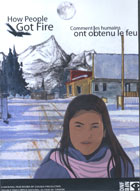
How People Got Fire 2009
Distributed by National Film Board of Canada, 1123 Broadway, Suite 307, New York, NY 10010; 800-542-2164
Producer n/a
Directed by Daniel Janke
DVD, color, 16 min.
K-12, College - General Adult
Film Studies, Animation, Native American Studies, Mythology, Media Studies
Date Entered: 01/12/2012
Reviewed by Oksana Dykyj, Head, Visual Media Resources, Concordia University, MontrealHow People Got Fire is based on an oral history by elder Kitty Smith from the Tlingit Nation in Canada’s Yukon Territory where she drew on the Tlingit and Southern Tutchone indigenous languages as well as English to retell tales. It is thus an animated tale whose provenance is from Kitty Smith’s father’s people, the Coastal Tlingit. It consists of a present-day story about a group of youngsters who visit Grandma Kay, a character based on Kitty Smith, to listen to her tell stories through the oral tradition of their culture. There is also a story within the present-day story which is the actual tale about how people got fire.
The present-day story is live-action treated through rotoscoping techniques and it seamlessly meshes with the myth of the raven/crow of the mythological tale being told by Grandma Kay. The mythological tale is rendered through traditional charcoal drawing and computer animation techniques. There is also a more elusive third world in this complex narrative, and this world is a surreal one that exists in Grandma Kay’s house: Photographs on the walls take on a life of their own to comment as an audience might; books open by themselves to express ideas; and images on coffee mugs animate at will in order to bring us in and out of the myth of how the crow collaborated with the chicken hawk to make fire a useful tool. Each animation technique expresses a specific narrative structure and the junction between present day and myth is expressed as a surreal intersection between the real and the fantastic. It is a very tight and clever narrative construction expressed by entrancing and ingenious uses of animation.
The film can be used in so many different ways in teaching. It could be used for social studies, for aboriginal studies, or for discussions about social and ethical responsibility. In fact, a study guide is available. But the film works just as well as a retelling of an age old story interpreted by hypnotizing animation. It could be watched for the sheer pleasure of seeing such beautiful animation unfold. Highly recommended for children of all ages and those interested in the study of animation techniques within Media Studies.